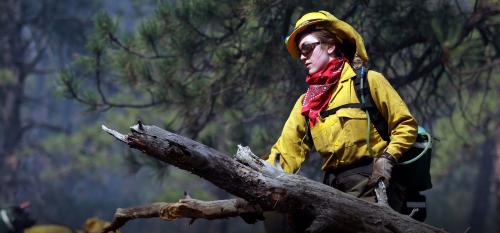National service holds out the promise of creating a fairer, better and more equal society. This is one reason why many policymakers, scholars and political leaders are urging an expansion of opportunities for service:
- Bipartisan legislation to expand national service was introduced in May 2020, in the form of the Pandemic Response and Opportunity Through National Service Act. If passed, this Bill would expand national service opportunities to 750,000 over the next three years, with a particular focus on programs directly related to COVID–19. The Corporation for National and Community Service (CNCS) currently offers 75,000 formal service opportunities through the AmeriCorps program and 200,000 through the Senior Corps Program.
- The National Commission on Military, National, and Public Service (NCoS), has provided a range of concrete steps in its final report, “Inspired to Serve”, published in March 2020 (some of which we return to below).
- Many scholars, including our colleague Isabel Sawhill, have urged a widening of service opportunities in order to build social capital and reduce polarization. In Sawhill’s terms, “It can build bridges instead of walls.”
But to fulfill its promise, national service must become more representative of the nation that it serves. Right now, service is skewed by gender, race, and class. Particularly noteworthy, especially in the context of renewed attention to issues of racial inequality and justice, are the much higher rates of service to the nation among Black Americans. After providing descriptive data on both military and civilian service, we examine policies to promote broader representation.
Civilian service skews female…
While military service still skews heavily towards men (4 out of 5 active duty enlistees are male), AmeriCorps – which accounts for 75,000 service opportunities each year- has more than twice as many female as male participants:
…While military service skews Black
There are differences by race, too. Here we compare the participation in AmeriCorps and the military with the civilian labor force, by race and gender. (Note that owing to data constraints we have assumed that the male/female balance is the same within each race for AmeriCorps).
Compared to the civilian labor force, Black men are significantly over-represented in military service, while Black women are similarly over-represented in civilian service. Among whites, women are significantly under-represented in military service, while men are significantly under-represented in civilian service. The overrepresentation of black men and women in the military can be seen as a double-edged sword. On the one hand, the military has served as an important means of economic mobility for many black men. On the other hand, the dominance of Black Americans in military service– and therefore among these most likely to be put in harm’s way on behalf of the nation – is striking, especially in light of broader current conversations about race, justice and equity.
Big class gaps in AmeriCorps representation
What about social class? AmeriCorps alumni have higher educational attainment compared to the general U.S. population. About 79% of AmeriCorps alumni had at least a 4-year college degree in 2016, a much higher proportion than in a similarly-aged population.[1] More importantly in terms of class background, the parents of AmeriCorps alumni are highly-educated too: 61% of AmeriCorps alumni’s parents had at least a 4-year college degree in 2016 compared to 30% of U.S. civilians aged 50 and above.[2]
There is a clear challenge here: to make civilian and military service more representative of the country as a whole. The question is; how?
Policies to promote more representative service
There are a range of measures that could be taken to widen both the scope and representativeness of service, above all in the report of the National Commission. Five steps in particular are likely to be required:
- Increase stipends. The current stipend value for full-time AmeriCorps members is $12,490, only just above the 2019 Federal poverty line for a household of one. Many are supported by family members, especially parents. Increasing the stipend value by, for example, $10,000 should allow more low-income individuals to participate in AmeriCorps programs. (Note that base pay for a new solider is around $20,000 – and they have room and board covered in full).
- Expand opportunities. In most years over the last decade or so, the AmeriCorps applicants-to-opportunities ratio has run somewhere between three to five applicants for each available slot. Simply creating more positions than the current 75,000 will not of course guarantee more representation but it is a likely precondition.
- Raise awareness. A big-bang public awareness campaign is needed, with particular focus on underrepresented communities. As the members of the National Commission noted: “The phrase ‘national service’ has no universally accepted definition in the United States, and it can evoke disparate images, ranging from volunteerism to specific service opportunities to mandatory military obligation.”
- Service apprenticeships. Increase coordination in the creation of apprenticeships and develop more national service models that qualify as Department of Labor apprenticeships. As employers cut back on available internship and apprenticeship opportunities, ensuring that the new national service opportunities qualify as apprenticeships could provide participants with more direct paths toward a new career.
- Draft women. Almost all men age 18-25 who are U.S. citizens or permanent residents are required to register with Selective Service. The commission recommends that all Americans, men and women, should be required to register for Selective Service and be prepared to serve in the event a draft is enacted by Congress and the President.
Service, both military and civilian, can both express and generate nationalism in the best sense of the term, described by the great liberal John Stuart Mill as “a feeling of common interest among those who live under the same government.” This is the kind of nationalism that means “one part of the community do not consider themselves as foreigners with regard to another, [but] feel that they are one people, that their lot is cast together.”
The extent to which “our lot is cast together” has rarely been clearer. Nor has both the need and the opportunity for Americans—for every American—to serve each other.
Notes
[1] The average age of AmeriCorps alumni in 2016 was 34 according to Alumni Outcomes Final Survey Technical Report, 2016, page 22.
[2] We assumed that the average AmeriCorps alumni parent was at least 50 years old in 2016.






Commentary
Black Americans are much more likely to serve the nation, in military and civilian roles
August 27, 2020